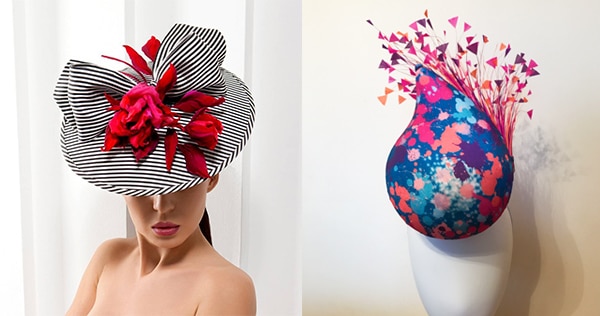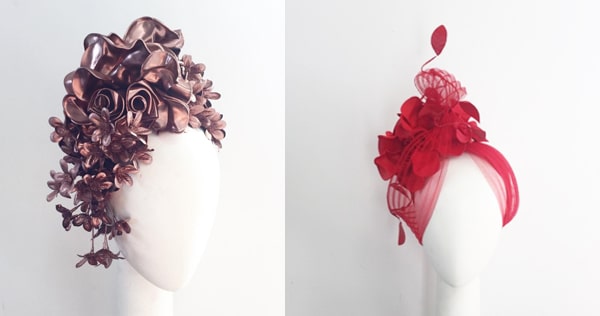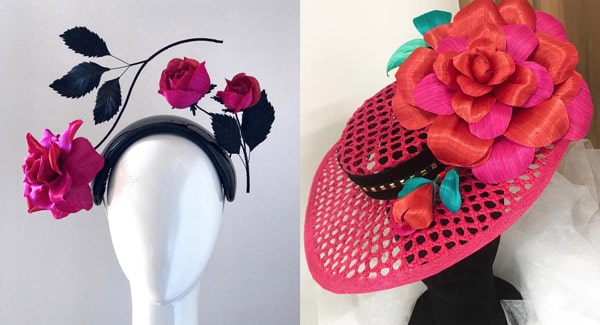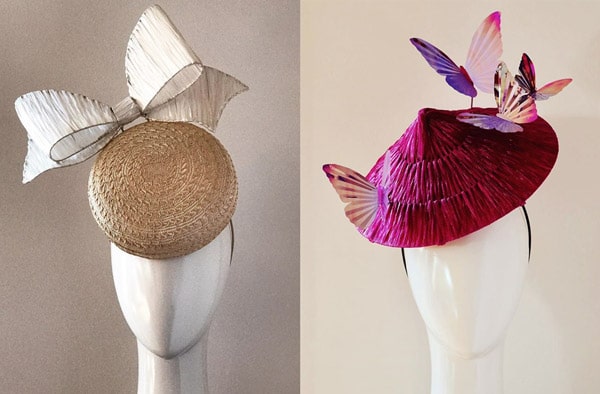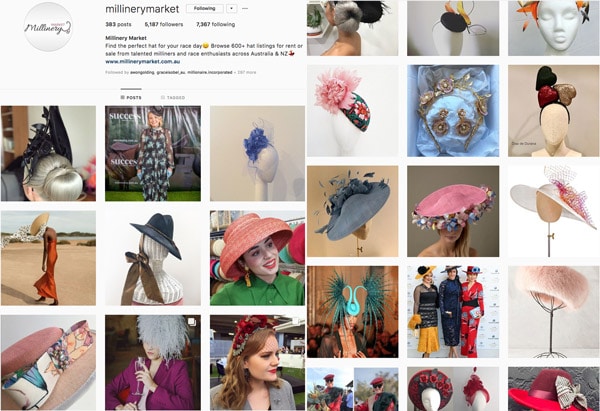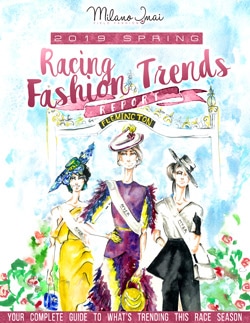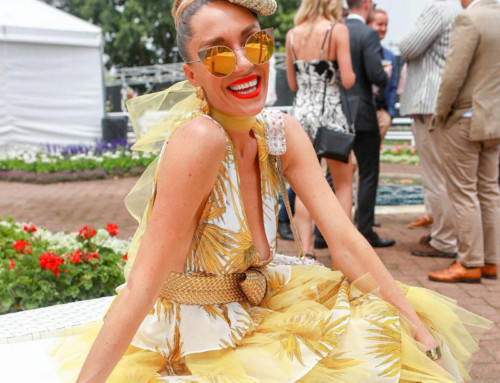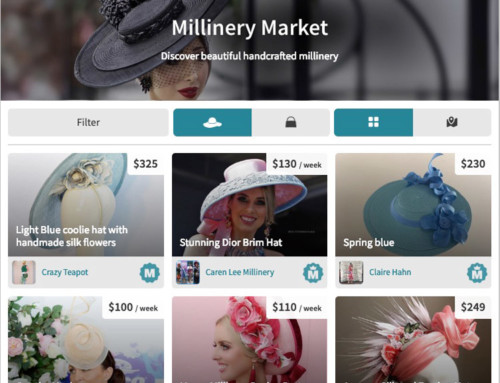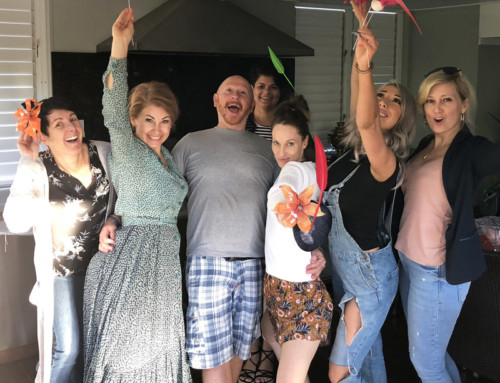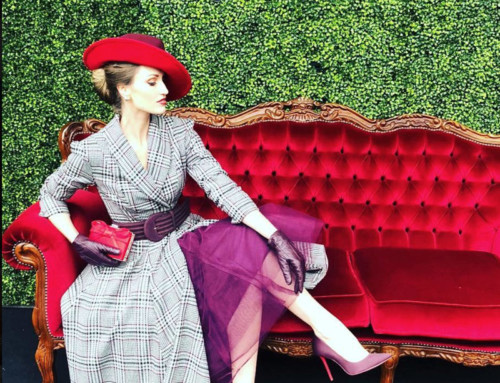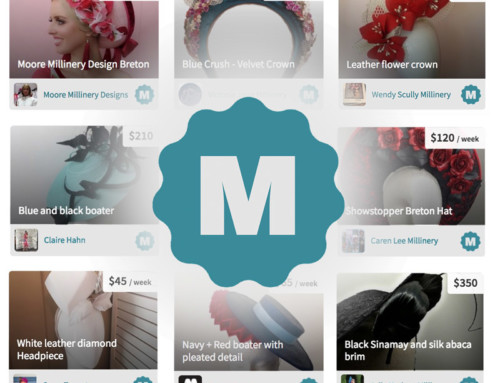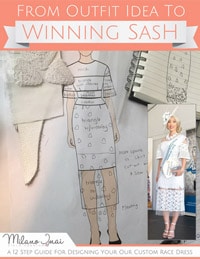Getting dressed up and wearing a hat to the races…how exciting!
These days, there aren’t many opportunities to wear one, so you should definitely make the most of it when you attend a race day. For most people, wearing a hat may only be a once-a-year occasion and it can be a bit daunting choosing a hat.

This ultimate millinery guide will explain the fundamentals of hat shapes and fabrications, provide advice for choosing the right hat, share tips for getting a hat made and finish up with some general information about millinery events, competitions and courses.
Here’s an overview of what I’ll be covering. Feel free to click on the headings below to jump to a specific section.
Contents
Part 1 – The Fundamentals – History, Hat Shapes & Fabrications
Before we talk about how to choose the right hat for your outfit, it’s good to have an understanding of common hat shapes and fabrications. A common mishap for new players is wearing hat materials that aren’t appropriate for the season, something that should be avoided.
The History of Millinery and the Races
Wearing a hat to the races is a tradition highly upheld, even today. The tradition dates back to the 1800s when men and women would dress in their finest, to represent their class and wealth status, which often included a hat. Not only were hats worn to protect against the elements, but also to display personal style.
In the past, horse racing was a sport enjoyed by the elite and provided the ideal platform for showcasing wealth. If you are attending the races today, you should definitely wear a hat to pay respect to a century long tradition, and hey, when else do you get the chance to dress up to the nines and wear a fabulous hat?
Wearing a hat is also a requirement if you wish to enter the Fashions on the Field competition, held at most race day events and in some member’s areas at race courses.
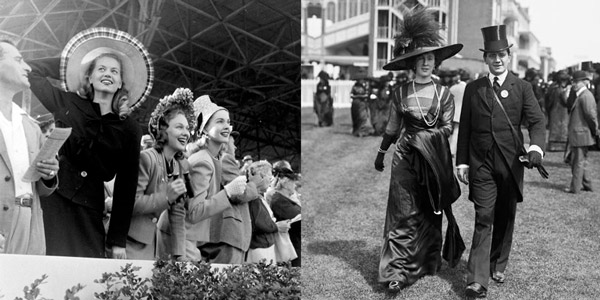
The Difference between Handmade and Factory Made
If you are familiar with the racing fashion scene, you might know that the word ‘fascinator’ is taboo. Fascinators are cheap and factory-produced in mass, overseas. They are sold at chain stores and there are thousands of copies of each design.
They are often glued or stitched together poorly. And even though they are mass produced, fascinators can still cost anywhere from $20 to $200+.
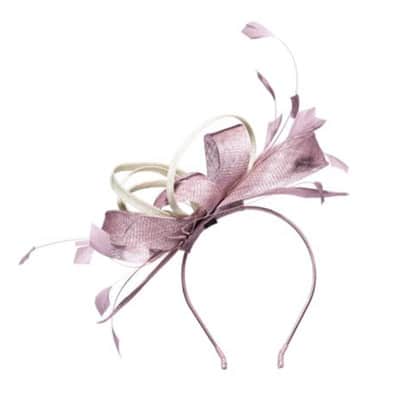
Millinery, on the other hand, is an art form. A milliner is someone who hand crafts a hat from scratch and has had intensive training to master their skills.
Milliners block the hat base using a range of techniques and then adorn hats with anything from feathers, beads, fabric flowers, quills, lace etc. The different words to use for millinery can be; millinery, hat or headpiece. Never a fascinator.
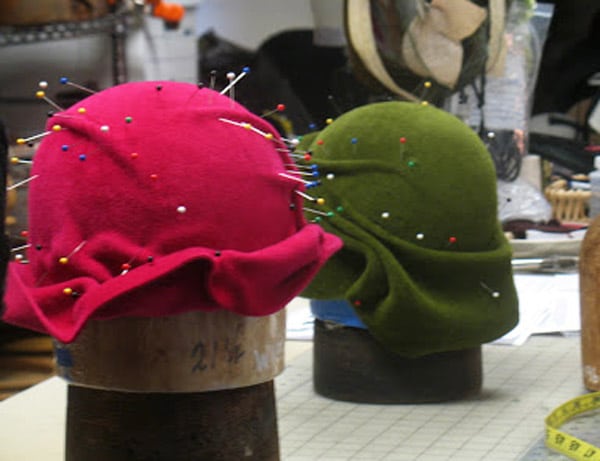
Image credit: jasminzorlu.blogspot.com
The Most Common Hat Shapes
There are many different styles of millinery available. Not all of them have a specific style name as each piece is individually crafted by hand and can be made into almost any shape one can dream up. However, some of the most common hat shapes seen today are:
The Boater
The boater is a very popular hat. It has a stiff crown and brim and was traditionally made from straw. Nowadays, the boater shape can be seen in both Spring/Summer and Autumn/Winter, made from straw, leather, felt etc.
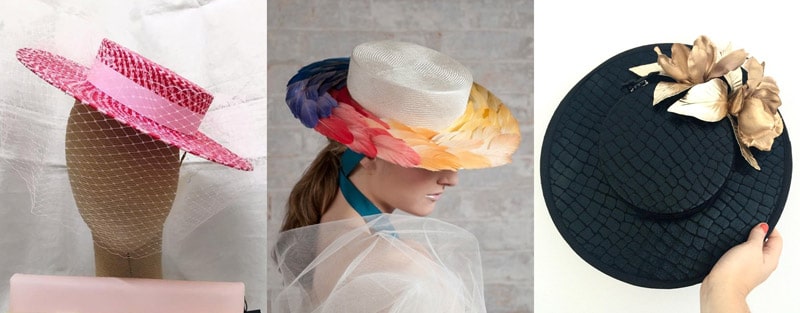
Image credit: @melissagayedesigns, @giulia.mio.millinery, @laurellouisemillinery
The Percher
Percher hats, do just that. They perch on the top of your head, usually centred on the forehead and give great height. They are blocked from a base, round and tear drop are most popular, and have embellishments added.
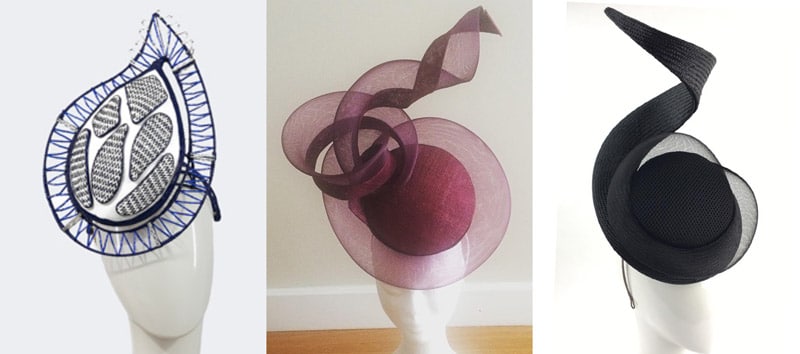
Image cred: @mooremillinerydesigns, @hatricksbymichelle, @rebeccashare
The Wide Brim
Probably one of my favourite style of hats, a wide brim hat features a crown with a brim that is enlarged. This style of hat makes a strong statement and looks amazing with a full skirt.

Image credit: @peacockmillinery, @nataliejanemillinery, @allportmillinery
The Crown
The crown is quite versatile in its form, as it can be made from any fabrications and out of numerous blocks or without any blocks at all. This refers to any hat that sits across the top of the head like a crown would.
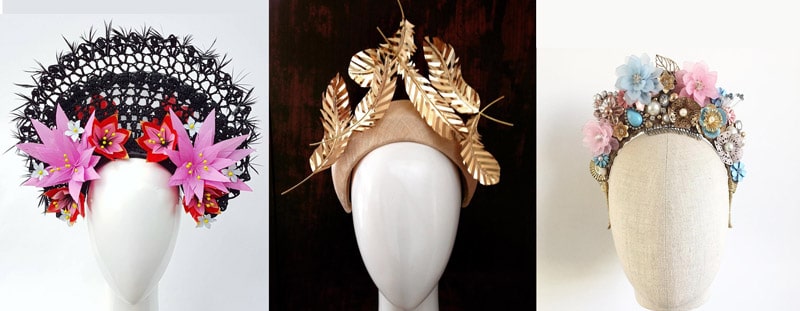
Image credit: @peacockmillinery, @lovelotus, @evetildawn
The Halo
The Halo is a hat that sits towards the back of the head and frames the head like a halo.
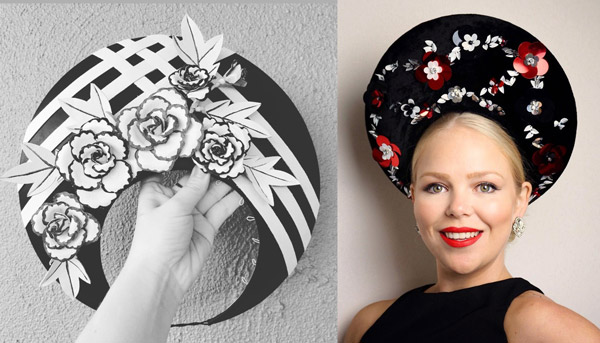
Image credit: @allportmillinery
The Breton
A Breton hat features a round crown (or no crown) with a brim that is turned upwards all the way around, a standout hat!
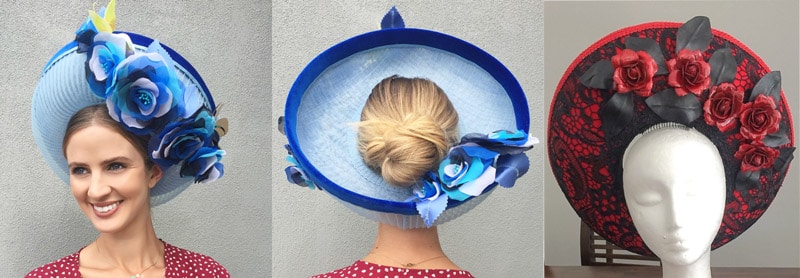
Image credit: @_themooretwins_, Caren Lee Millinery
The Free Form or Structured Hat
Hats are sculpted works of art and don’t need to be blocked off a base. They can be created freely, as the milliner works, being moulded and shaped in different ways. The possibilities of creation are endless.
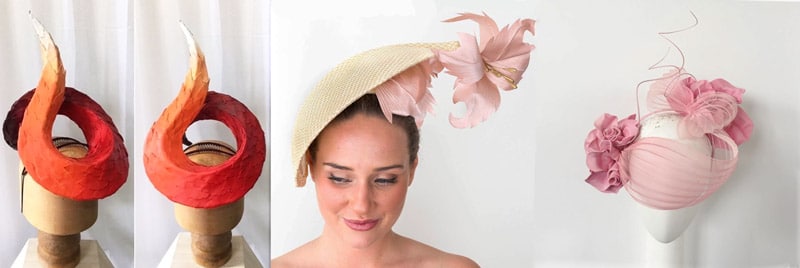
Image credit: @melissabarnes_1, @felicitynortheastmillinery, @clairehahnnz
The Fedora
A fedora is traditionally a soft felt or velvet hat with a curled brim and a crease down the middle. Fedora’s can be made from other materials too, to suit different seasons.
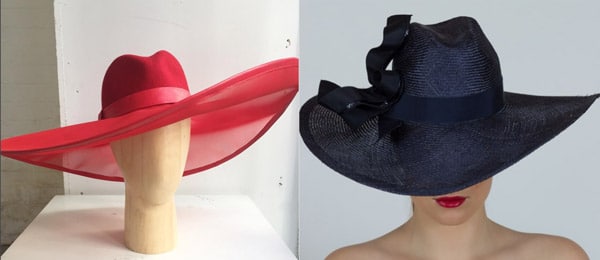
Image credit: @awongolding, @felicitynortheastmillinery
The Turban
The Turban shape has been quite popular in millinery lately. It gives milliners a wide scope to experiment with different materials and styles when creating a turban look.
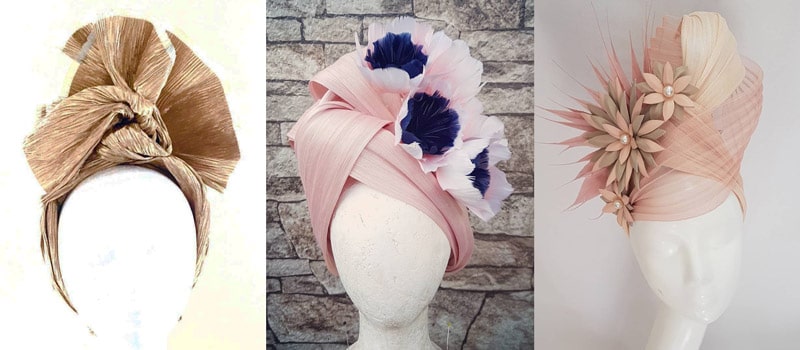
Image credit: @nataliejanemillinery, @peacockmillinery, @millinerybymel
The Beret
Berets, mostly seen in Autumn/Winter, are gaining popularity once again in the racing world. They can be made out of soft leathers, felt and wools.
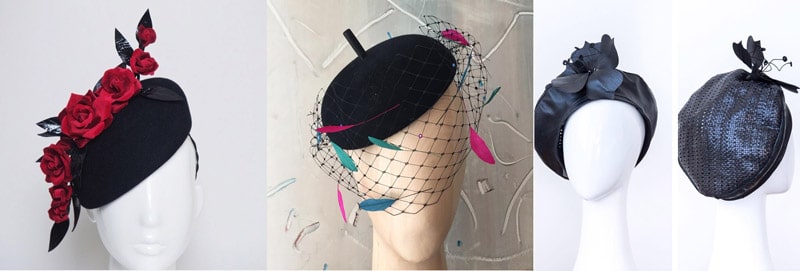
Image credit: @allportmillinery, @awongolding, @felicitynortheastmillinery
The Disc
The disc shape is a favourite of mine. It is basically a disc shape, that can be slightly moulded to sit at a 45 degree (or higher) angle off the side of the head.

Image credit: @allportmillinery, @makermillinery, @felicitynortheastmillinery
The Dior Brim / Mushroom
A favourite shape of mine is, what has been dubbed, the ‘Dior Brim’. This hat has a brim which angles downwards, in a sort of mushroom shape. I find this hat so feminine and classic.
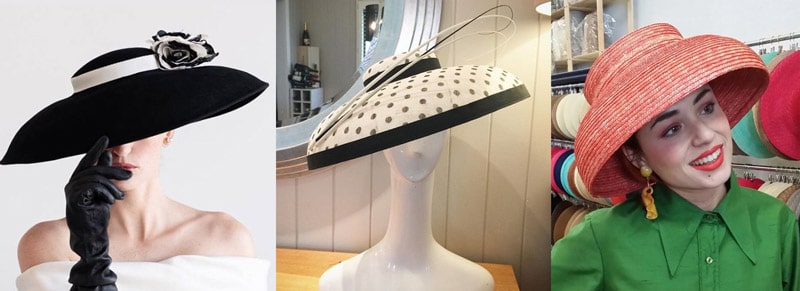
Image credit:@marilynvandenberg, @marilynvandenberg, @masario.es
The Donut
A very popular hat shape to come about recently is the ‘donut’ shape. This hat is exactly how it sounds, a round ring shape that often sits to the back of the head. It can be made out of all sorts of materials and adorned with trims such as flowers, feathers, veiling, beads etc.
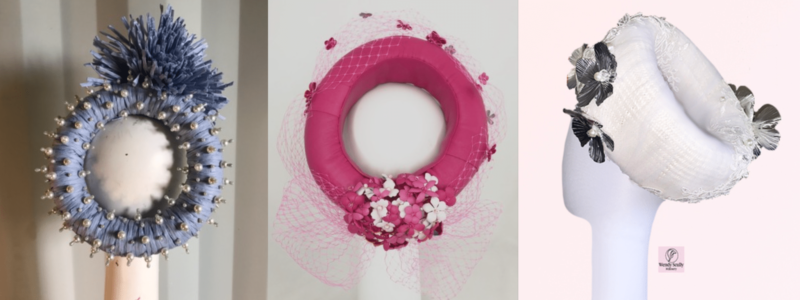
Image credit: @clairehahnmillinery, @marjoribanksmillinery, @wendyscullymillinery
Millinery Trends
Just as with fashion, millinery trends change each year. The fabrications, colours, shapes and techniques used can change to suit what is trending.
It is unknown who decides what will be the new ‘in’ look for millinery, perhaps inspiration is taken from hats featured in Couture runway shows, hats worn to a royal wedding or what celebrity milliners are creating. Once something gains popularity you will see quite a few milliners jump on board and create their own version of the trend.
In recent years, we have seen the percher, boater, wide brim hat, crowns and halos as being the favourites amongst race goers. Check out this blog post to learn more about Millinery Trends.
Fabrications for Different Seasons
It is very important to take note of different fabrications used for different seasons. If you are entering the Fashions on the Field competition, judges are on the look out to make sure you are wearing season appropriate fabrications.
Below is a list of common fabrications and the season they are appropriate for. For a more in-depth look at dressing for seasons read this blog post.
Leather
Leather is trans-seasonal and can be worn in both S/S and A/W. Select appropriate colours to match the season; brighter colours in S/S (i.e. yellow, pink, blue, orange, green, white) and rich winter tones for A/W (i.e. burgundy, red, emerald, navy, brown, burnt orange, deep purple, black).
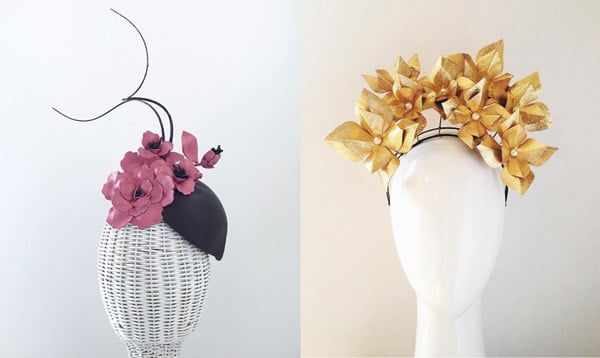
Image credit: @makermillinery, @lovelotus
Felt / Fur
For millinery, this is a definite A/W-only fabrication. In FOTF, you would be penalised if you wore a felt hat in spring. Felts come in so many beautiful colours and look fantastic worked into a variety of shapes from fedoras, boaters, turbans and pillbox styles.
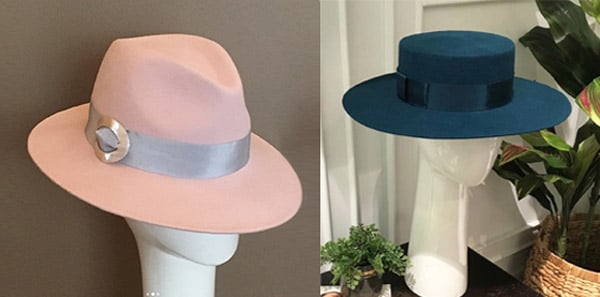
Image credit: @mooremillinerydesigns, @martina_mcgrath_millinery
Straw/Sinamay
The perfect lightweight fabrication for S/S, straw and sinamay cannot be worn in A/W. This fabric is also used to make a variety of silhouettes and is easily shaped. It can also be dyed almost any colour. Straw and sinamay are the most common fabrications used in bases and be covered in different fabrics, once shaped.
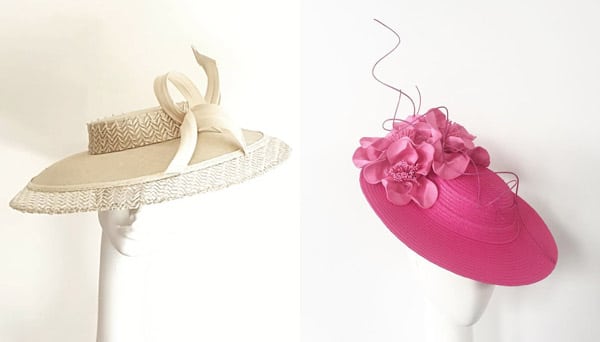
Image credit: @monika_neuhauser_millinery, @clairehahnnz
Fabric covered
As mentioned above, hats can be made from various materials and then covered in a fabric. Your choice of fabric will determine if it is S/S or A/W appropriate. A thicker fabric with a winter colour can be used in A/W and something bright and vibrant is fine for S/S. If you have a base blocked in a S/S fabrication such as sinamay, you can cover it to make it A/W appropriate with a fabric such as wool or tweed, as long as you cannot see any of the sinamay.
Jinsin
Jinsin is a woven straw fabric and, therefore, used in S/S. Jinsin is favoured for its sculptural qualities and you can also fray the edges, which looks really cool.
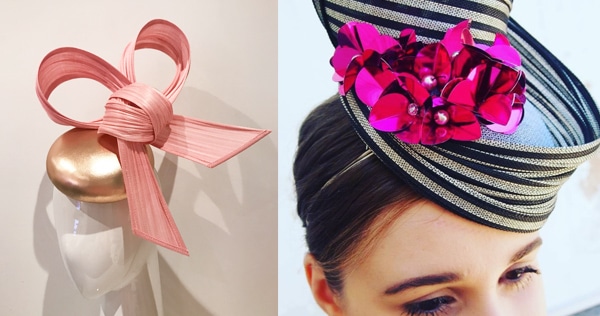
Image credit: @designsbyshimmer, @mohdeest_millinery
Eva Foam
A lightweight foam that is easy to mould, eva foam has gained quite a bit of popularity amongst milliners. Eva foam is thought to be both S/S and A/W appropriate.
Silk/ Silk Abaca
Silk abaca is a fabric made from silk and abaca fibre. It is popular due to how beautifully the fabric holds colour and has a beautiful sheen to it. Silk abaca is a S/S fabrication due to its light weight and straw like appearance.
Velvet
Velvet, as I’m sure most of you can guess, is an A/W fabrication. Velvets look expensive and present a lovely textured appearance, especially printed velvet.
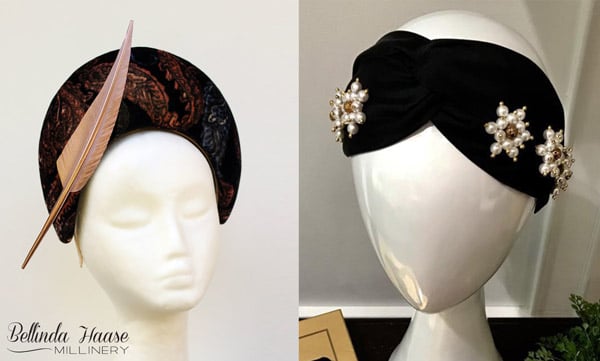
Image credit: @bellindahaase, @martina_mcgrath_millinery
Perspex/ Thermoplastic
Perspex and plastic hats are appropriate for both S/S and A/W. The deciding factor is the fabrications you choose to pair it with, so select something to suit the season.
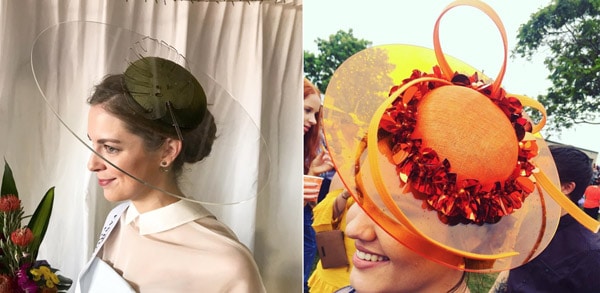
Image credit: @makermillinery, @mohdeest_millinery
Raffia
Raffia is a fun natural fibre to work with as it is strong, durable and easy to dye. It is only to be worn in S/S.
Metals
Metal fabrics such as aluminium and metal sheets can be used in millinery to create interesting and unusual designs. Metals are trans-seasonal.
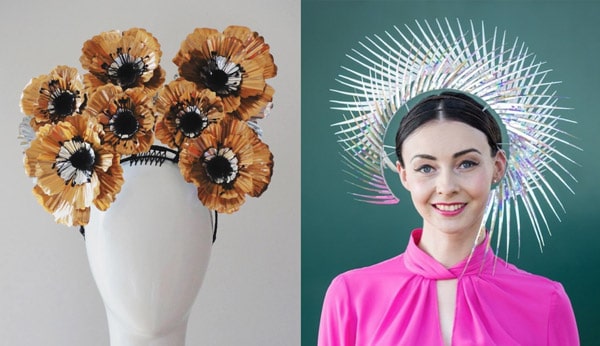
Image credit: @lovelotus
Crinoline
I love the effect of crinoline as a trim for millinery. In my opinion, crinoline is appropriate for both S/S and A/W and is a beautiful touch to add depth and contrast to other fabrications.
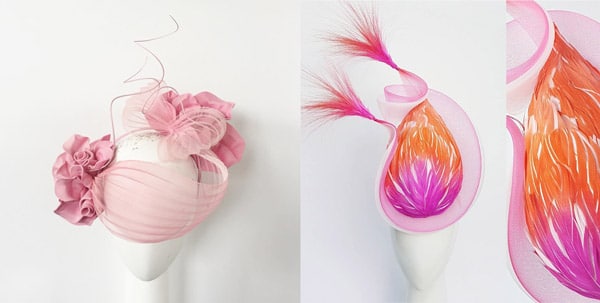
Image credit: @clairehahnnz, @peacockmillinery
Braid
Braid is usually made from woven strips of cellophane. Cellophane being a plastic fabrication means it can be worn in S/S or A/W, however some people see braid as being mainly for S/S. Braids can be sewn together to form the base of a hat, or used in strips with wire sewn in to create shapes.
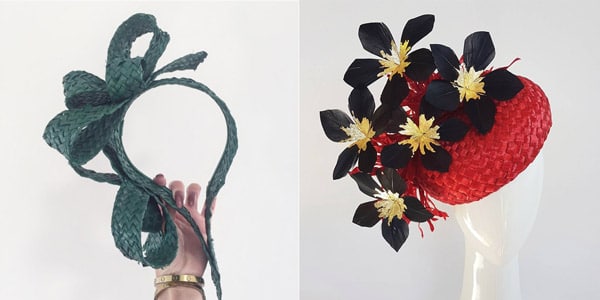
Image credit: @clairehahnnz, @peacockmillinery
Veiling
Veiling is a very big trend this year and is suitable for both S/S and A/W. Choose a lighter colour veil for S/S and a heavier, darker veil for A/W. Veiling can be worn over the face or as part of an embellishment on a hat.
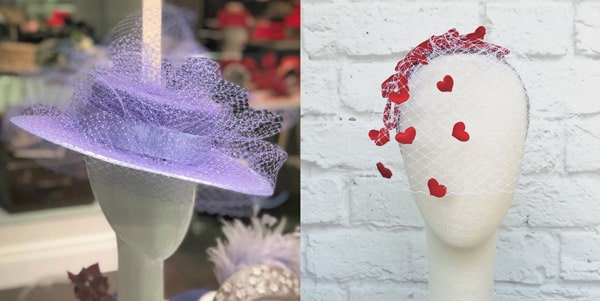
Image credit: @felicityboevinkmillinery, @sweetpeafinery
Embellished
Stones and embellishments can be used in headbands and crowns in S/S or A/W. A jewelled headband in emerald, deep blue and burgundy would look stunning in A/W, whereas, light coloured embellishments will shine in S/S.
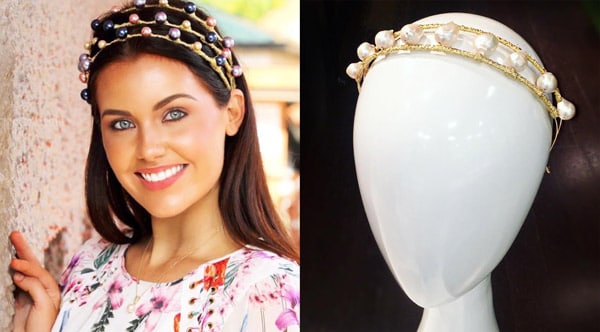
Image credit: @felicityboevinkmillinery
Feathers
Feathers are a trans-seasonal fabrication perfect for embellishing hats, or worn alone as a structural piece. Feathers can be cut and dyed into numerous styles and are a lot of fun to play around with.
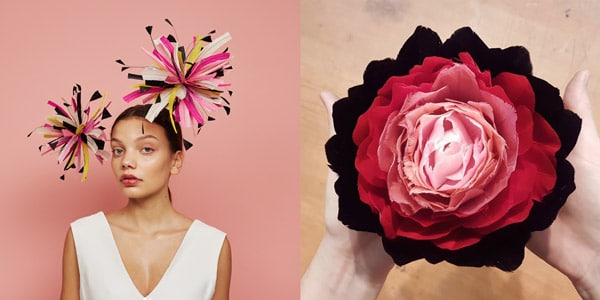
Image credit: @awongolding, @peacockmillinery
Mesh
Stiffened mesh is often used in millinery and typically for S/S, however, I have seen a small trim added to a leather piece for an A/W look. Just a touch may be overlooked, if it is mistaken for a mesh made of leather or plastic.
Part 2 – How to Choose the Right Hat
Now that we’ve covered the fundamentals of hat shapes and fabrications, I’ll share some tips for finding the right hat to suit your outfit.
Which Comes First – Dress or Hat?
Some people like to decide upon their outfit first before selecting a hat, others are inspired by a hat and plan a whole outfit around it. Personally, I find it easier to start with an outfit and then have a hat made to complement.
How to Choose a Hat Shape to Suit your Dress
Selecting millinery is all about balance and making sure the overall look works together nicely. If you are having a hat made, you would show your design or outfit idea to your milliner, who then draws up some ideas for you.
When selecting a hat, the shape of the dress is important. If you have a full skirt, then you may want a bigger piece of millinery to balance out the silhouette.
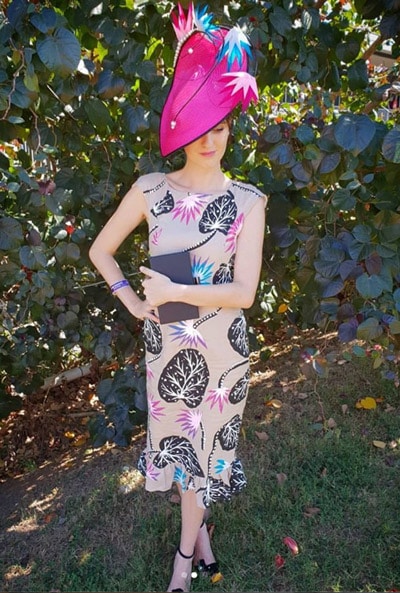
Here @becccaah wears a stunning @peacockmillinery hat that plays on the print in Becca’s dress. The hat mimics the leaf print, whilst the embellishment matches the flowers in the dress. The dress itself, is quite simple in terms of silhouette, so having a statement hat is a good choice.
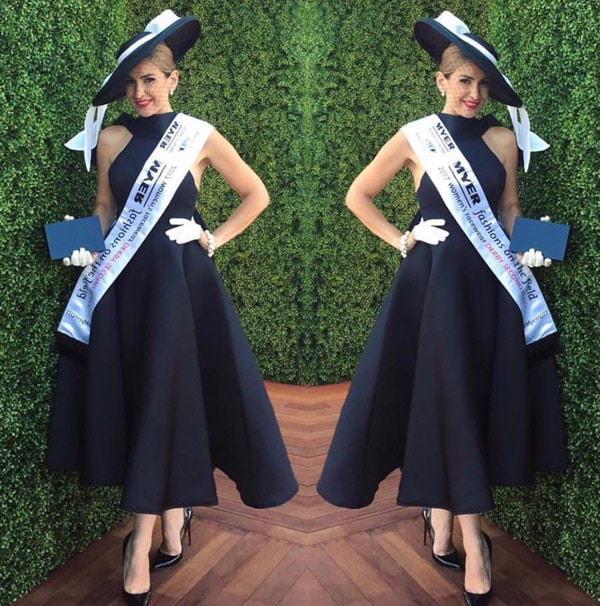
In this outfit, @tanyalazarou has chosen a wide brim hat to complement her full skirt dress. Her dress is quite voluminous, so a small hat would get lost and look unsubstantial with this outfit, whereas the wide brim balances it out nicely.
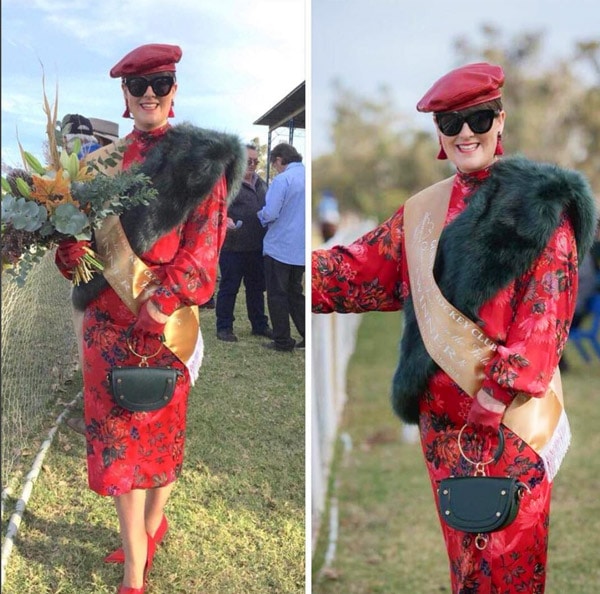
Jessica’s choice of a simple beret was perfect for her otherwise busy outfit whilst complementing it but not overcrowding it. She has a lot going on in terms of accessories and colour, so a simple hat was the way to go.
The beauty of millinery is that there are many different styles that suit a range of silhouettes and sometimes the best thing to do is to ‘try on’ different hats with the outfit. You can do this with the Millinery Market Hat Filters and an app called ‘Pic Collage’.
Using the Millinery Market Hat Filters to Choose a Hat Shape
I created these augmented reality virtual hats so that you can quickly ‘try on’ different hat shapes to see what will work best with your outfit. The hats look very realistic and they move with your head so when you wear your outfit in front of a mirror it gives you a really good feel for what it will look like when wearing the hat.
There are 11 different hat shapes including Face Hugger, Saucer, Pillbox, Turban, Beret, Top Hat, Headband, Percher, Boater, Wide Brim and Crown. For each hat you can choose from 16 colours so you can see what colours will match your outfit.
You open the hat filters in your Instagram or Facebook camera. Read this blog post to see how it works.
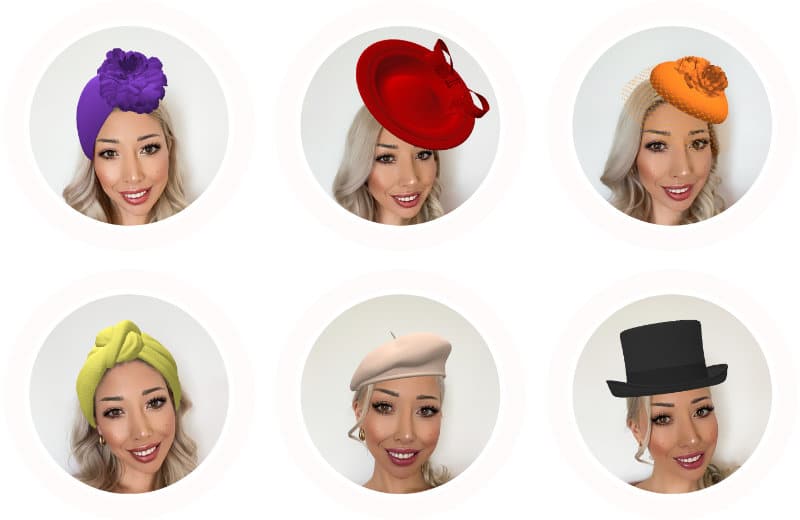
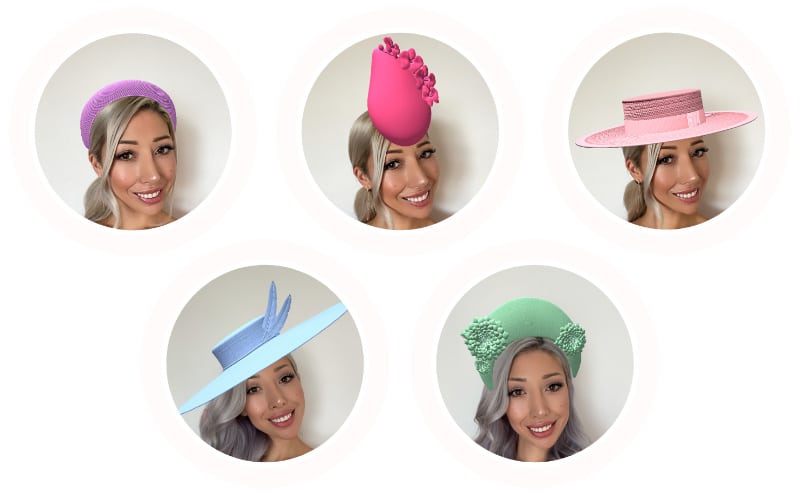
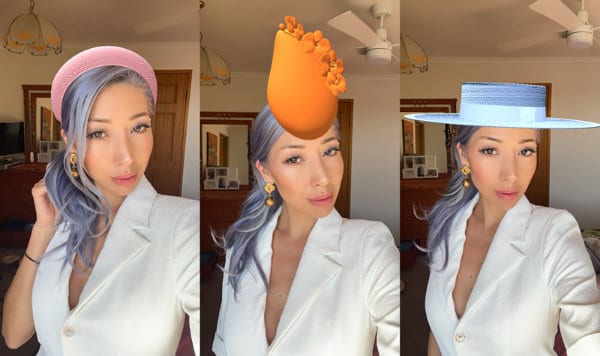
Using the PicCollage App to Visualise your Outfit
PicCollage is a phone app that you can use to help you visualise how your hat will look with the rest of your outfit.
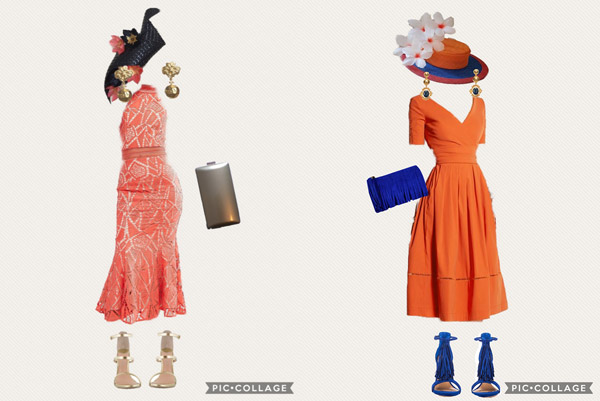
Basically, you start with a blank canvas. Then you bring in the photos you want to use, cut around the pictures using your finger and make a collage of your dress, millinery, shoes and accessories. The end product is an image of the entire outfit right before your very eyes!
Sometimes you might have an entire outfit, except for your millinery. Which hat should you pick? Unlike the Millinery Market Hat Filters, this gives you a static 2D image of your outfit but it allows you to visualise how a specific hat will look.
Take a photo of yourself in your outfit and then use PicCollage to ‘try on’ a number of different hats from the comfort of your home. A full guide on how to use it can be found here.
How to Tie Your Millinery in with Your Outfit
To tie millinery into your outfit, you can either choose to select a colour from your outfit or a fabrication. Your millinery doesn’t have to match a colour though; you can always use your millinery to introduce an entirely new colour.
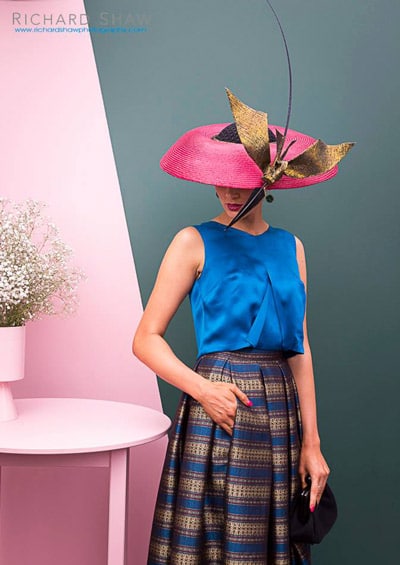
Image credit: Richard Shaw photo of Louise MacDonald hat.
Your millinery shape should complement the shape and style of your outfit. If you have soft round prints or shapes in your dress, you could continue that onto your hat.
You can also take a feature or print from your dress and use it in your millinery. Flowers are a perfect example. If your outfit features roses, then find a rose embellishment, made out of feathers or leather (for example) as a feature on your hat.
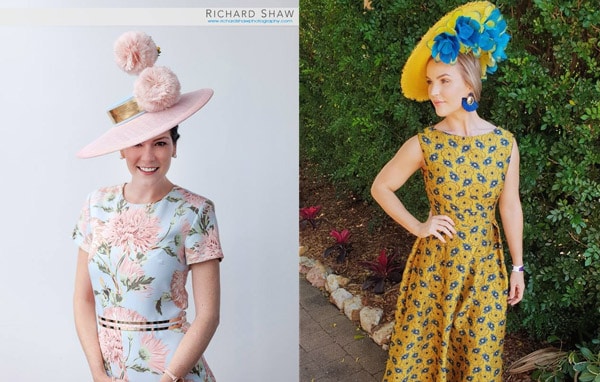
Image credit: Richard Shaw photo of @stef_stefx, @peacockmillinery photo of @hannahfarmer24
Or if your outfit has a print that features a certain pattern, you could remake that shape onto your hat.
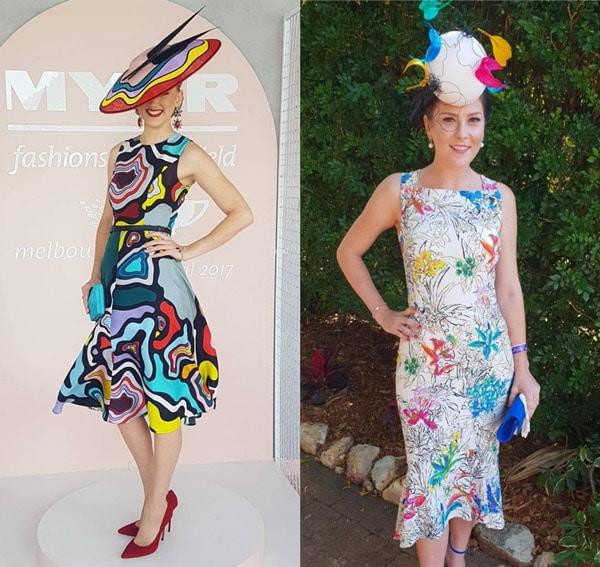
Image credit: @brooke.prince, @peacockmillinery photo of @stef_stefx
If you have a plain dress, your millinery can become the ‘wow factor‘ by making it your standout feature.
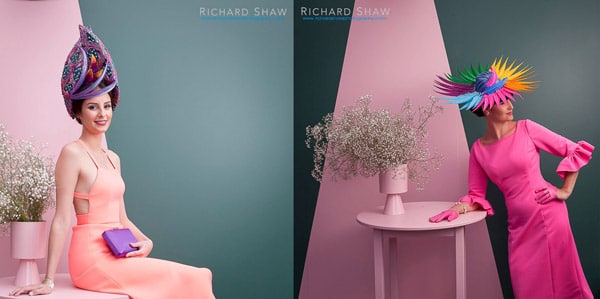
Image credit: Richard Shaw photo of Julia Watson’s millinery design and of Angela McCormick.
Hairstyles and Hats
Hair is an extension of your millinery. When wearing a hat, never underestimate what a beautiful up-style can do to balance out a bigger hat, or to accentuate a smaller piece of millinery.
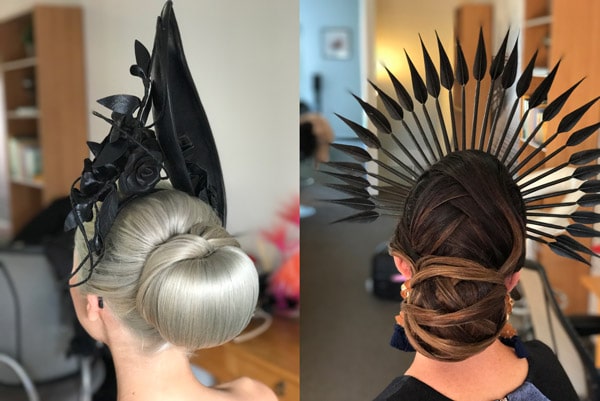
Image credit: @milanoimai, @peacockmillinery

Image credit: @_cloflo, @milanoimai
There have been occasions where I have tried on an outfit and millinery and thought that my hat was too big and looked silly, but once my hair was styled with volume, it balanced out and looked perfect.
Click here to see some stunning hairstyles to complement different types of millinery.
Ready Made or Bespoke?
Should you buy a ready-made or bespoke hat? I have broken down the benefits for each below…
Ready made hats
Pros:
- Know exactly what you’re going to get as you can try it on.
- Quick delivery. Good for last minute events or when you wouldn’t have time to get a hat made.
Cons:
- If you have something very specific in mind, it may be hard to find a ready made hat.
Where to buy: Milliners often have a ready-made collection which you can buy on their website. If there’s a physical store near you, the advantage is being able to try it on. You can also buy or hire hats on Millinery Market, and see a wide variety of hats all in one place.
Bespoke Hats
Pros:
- Can get something made to perfectly match the rest of your outfit.
- It allows you to be even more involved in the design process, making you feel proud of coming up with a complete outfit that you had such a big part in creating.
- One of a kind. You’ll have something that hasn’t been seen or done before, which can really impress the judges and give you an edge in FOTF.
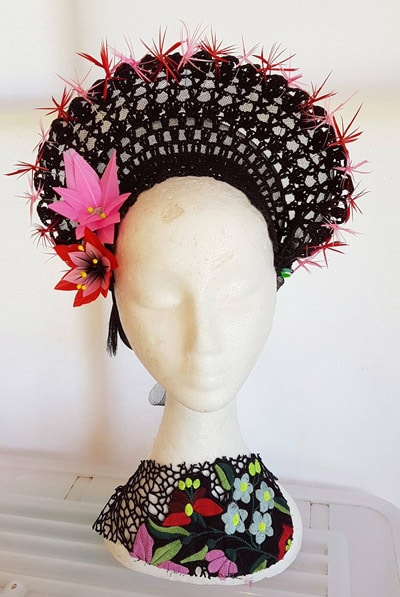
Image Credit: @peacockmillinery
Cons:
- Takes longer to ship.
- Risk that the finished product isn’t what you initially envisaged.
- Can cost more than expected if you make major changes along the way.
Where to buy: Getting a bespoke hat made is more involved than buying a ready made hat, so I’ll discuss this in more detail in the next section.
Part 3 – Getting a Bespoke Hat Made
Now that you know how to choose the right hat, let’s have a look at how hats are made and how to go about getting a bespoke piece made.
How Are Hats Made?
Hats are made in various ways but the most common is by ‘blocking’ a base. This means that you take a millinery fabrication whether it be straw, felt or leather etc. and use water and heat to mould it around a wooden hat block, using pins to secure it in place. Hat blocks come in many different shapes and sizes and each create their own unique shape.
You can get custom hat blocks made through Hat Blocks Australia or pre purchase them online. Once the base of the hat is made, a milliner can then cover the base in any chosen fabric and add embellishments.
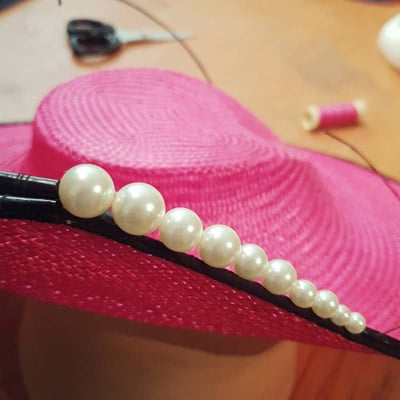
Image credit: @peacockmillinery
Embellishments can be what really make a hat stand out, whether it be feathers or leather made into beautiful hand-crafted flowers or arranged quills. You can decorate a hat with almost anything you like.
How Long does it Take to Make a Hat?
Hats can take anywhere from a few hours, to weeks, depending on how intricate or difficult it is. A hat that requires blocking can take longer as the fabric needs time to dry and then has to be hand stitched together.
Fabrics may also need to be hand dyed to get the desired colour or ordered in from overseas. Whilst a simple hat can be made within a week, it is best to book a milliner to make a bespoke piece well in advance. I would contact a milliner 6 weeks before your race day, or earlier, to start discussions about designs and ideas.
During the busy times, milliners can be booked out as much as 3+ months prior, but otherwise three weeks to a month could be enough time, depending on what you are after.
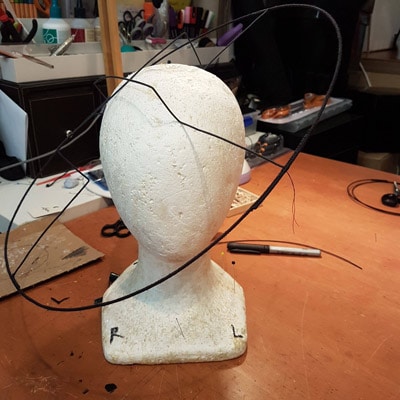
Image Credit: @peacockmillinery
How Many Milliners?
It is unknown exactly how many milliners there are in Australia and New Zealand. We can get a rough idea from The Millinery Association of Australia, who have over 120 members across the country who have met specific training criteria. There are a lot of hobby milliners and milliners who are self-taught too.
Choosing a Milliner
Selecting a milliner is an integral part of your outfit coming together. A milliner whose style you like and who you can communicate and work together with, is key. The best way to find which milliner best suits your personal style is to look through some different collections and see if you like their set of skills.
Each milliner can specialise in different areas, whether it be certain fabrications or shapes and even in their embellishments.
Milliners often have out-dated webpages, without their new hats or work featured, so the best place to check out milliners is on Instagram or Facebook. I do my best on @millinerymarket Instagram account to feature a range of different milliners and their work, so if you have a look through there, I am sure you will find a few that you love.
If you are after a bespoke piece or want to know more about different milliners, a great place to look is on the Millinery Market ‘Milliner Directory’. The Milliner Directory shares with you a milliner’s training and experience, location so you can find someone near you, millinery style and specialisations and their average prices for a bespoke piece.

Typical Process for Getting a Bespoke Hat Made
To get a custom piece made, you will need to contact your milliner through their website or call them on the number listed. Make sure you allow enough time as milliners’ work schedules can get booked up, especially leading up to big events like Spring Carnival.
Have a chat on the phone about pricing, time frames and an idea of what you want, so the milliner can decide if they are able to make it for you. It is always best to set out in writing what you have agreed upon so there are no misunderstandings later on.
Once you have decided upon a milliner, you may choose to meet in person or have a Skype call. You can show your milliner your outfit idea, or if you already have your outfit you can send photos of it. You can then discuss shapes, colours and embellishments.
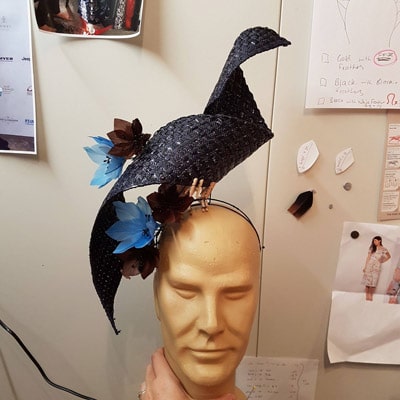
Image Credit: @peacockmillinery
As your milliner works on your hat, they may choose to send you update photos to check you are happy with how it is progressing and if you would like any changes. Any significant changes may cost you more than what you agreed upon originally, as more time may be needed.
Once your hat is completed, you can pick it up or have it sent to you in the post.
Should you Give a Milliner Creative Freedom?
Some milliners like to have complete creative freedom, which is not at all a bad thing. A milliner I regularly use, has complete control over the style she will make for me. That’s because I trust her style and know she will come up with something perfectly suited to my outfit.
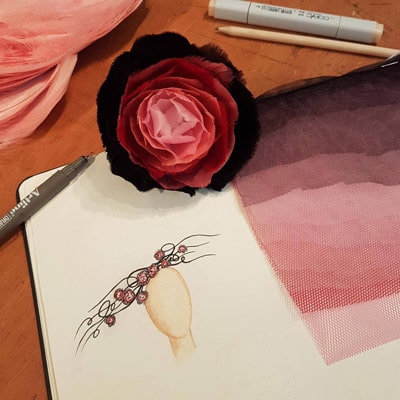
Image credit: Peacock Millinery
Other milliners may prefer your input, so they know you will be happy with what they create and you share the same vision. If you already have a design in mind and want that exact style made, then that is possible too.
A note here: if you have seen a hat that you love the look of and want one for yourself, you should find out who the original designer is and contact them to make you something similar. A different milliner would not be comfortable copying another milliner’s work.
How Much do the Hats Cost?
Millinery can cost anywhere from $300 to $3000. It depends on whether you buy ready-made or have something custom made, the design you want, and who’s making it.
Ladies who are just starting out are sometimes surprised by how expensive the hats can be. It’s important to recognise that millinery is a skill that takes many years to master and you are paying for the milliner’s skills, creativity and experience, just like you would for a painting or sculpture. Millinery is hand made using high quality and often expensive materials and can sometimes take weeks to make.
Most often, your hat will cost between $300 to $500, but if you want something intricate or created by a famous milliner, $1000 can also be the starting point. This is why it is always good to set out a guideline of how much you would like to pay before going ahead with a milliner.
Value of Knowing Basic Embellishment Skills
Having a hat that you can wear multiple times comes in handy because getting a new hat for every race day you attend, will become quite costly. Then there are the unexpected race days, the ones you weren’t planning on going to…and changed your mind last minute. You’ll need to quickly change up a hat for those.
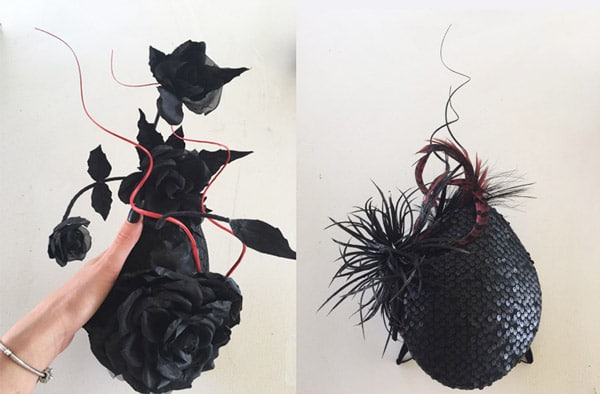
Knowing a few basic skills, like how to add embellishments such as quills, feathers, flowers or even covering a hat with fabric is priceless. Read this post to learn some tips on what makes a good hat and how you can change your hats up.
Part 4 – Millinery Events, Competitions & Learning Millinery
Millinery Events throughout the Year
This section will be populated over time. Let me know if you are hosting a millinery competition, workshop or event and I’ll add it in here.
National Millinery Competition
The National Millinery competition is held by Myer every Spring Carnival at Flemington Racecourse on Oaks Day. Selected milliners are invited to partake in the prestigious competition, to show off their design entered by a model, or modelled by themselves.
The winner of the Millinery competition can win some amazing prizes. To give you an idea, last year’s winner’s prize pool included return flights for two to London, $2000 travel voucher, hotel accommodation voucher, $4000 Myer Gift Card, a fashion feature inside a magazine and $1000 worth of Antler Luggage.
The previous 9 winners have been:
Stephanie Spencer 2020

Image: @stephaniespencer__
Cynthia Jones Bryson 2019

Image: @cynthiajonescrysonmillinery shot by @richshawphoto
Rebecca Share 2018

Image: @rebeccashare shot by @richshawphoto
Sarah Schofield 2017
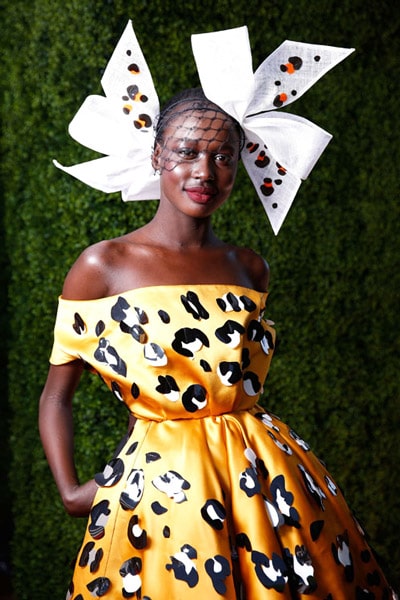
Image credit: flemington.com.au
Ian Bennet 2016
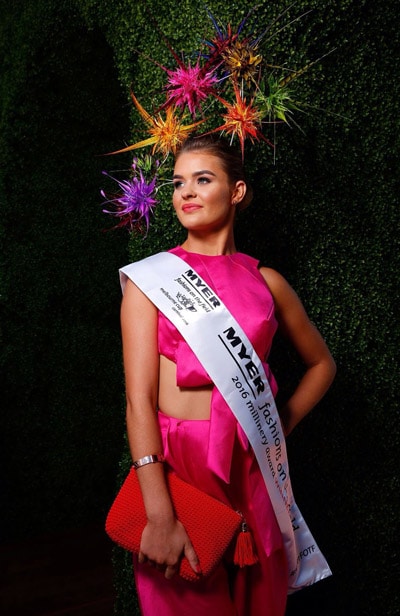
Image credit: flemington.com.au
Cynthia Jones-Bryson 2015
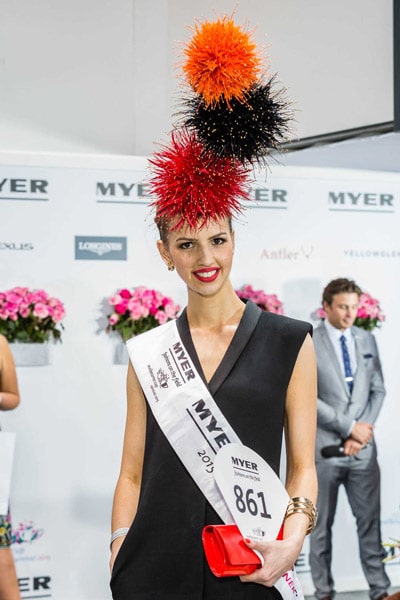
Image credit: millineryaustralia.org
Jill Humphries 2014

Image credit: heraldsun.com.au
Studio Aniss 2013
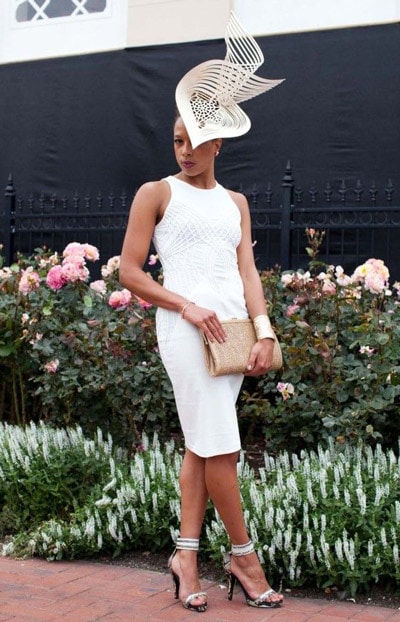
Image credit: vogue.com.au
Love Lotus 2012
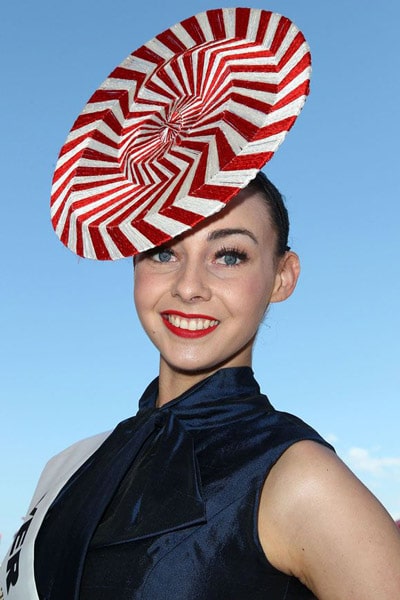
Image credit: pinterest.co.uk
Study Millinery and Become a Professional Milliner
One skill I would love to learn is to make millinery, there are a few ways to do this.
Some TAFE’s across Australia offer millinery courses, otherwise you can sign up for some online courses through Hat Atelier or Hat Academy.
Another great way to learn some skills is through workshops that milliners hold at various times throughout the year. With the worldwide pandemic with many people stuck at home and unable to travel, a lot of milliners held virtual classes to teach millinery skills. A list of online classes and workshops can be found here.
If you’re not sure whether you want to go down the path of becoming a milliner, you can also start out by watching some Youtube videos and self-learning to get a feel for what it’s like.
A lot of great milliners are self taught but to be recognised and registered with the Australian Millinery Association you must have completed a Certificate IV in Millinery or any other formal or informal teaching up to so many hours as reviewed by the committee.
I hope this ultimate guide has given you some ideas for choosing your next hat. For more tips and discussion about millinery and dressing for the races, come join our 3,500+ members in the Field Fashion Community Facebook Group!

